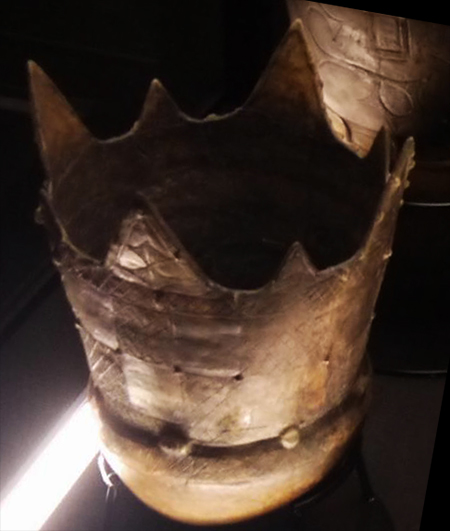

わたしはテレビの地上波番組はスポーツ中継かNHKニュースくらいで
ほとんど見ませんし、新聞も見なくなって15年近い。脱マスコミ生活。
それでもときどきBSのNHK番組は見る。
(受信料は払っています、反対ではありますが悪法も法なり。)
歴史家・磯田道史が導く「英雄たちの選択」は毎回、楽しみにしています。
最新の歴史・考古の研究成果が幅広くわかりやすく語られていて
非常に面白く拝見しています。とくに準レギュラー脳科学者・中野信子さんが
コメンテーターとして心理分析を歴史事実に対して語っていく様は
歴史との親和性があり学際的で尽きない興味を提供してくれる。
この「英雄たちの選択」からのスピンアウト版として
「古代人のこころを発掘せよ!!」というテーマ番組が放送されていた。
ほんとうはことしの正月の放送だったそうですが再放送が日曜日18日に。
知らずに外出していたのですが、カミさんが好みを知っていて録画してくれた、感謝。
いくつか「これは一度探訪しなければ」という博物館・歴史館紹介がありましたが
とくに表題の縄文人の「こころ」について
その造形ぶりからの論考で件の中野信子さんからの指摘が素晴らしかった。
かねて弥生の土器以降は「用に徹する」現代人と同様の感覚を感じていましたが
縄文土器には相当異質な感受性を受け止めていた。
その異質さ、造形プロセスでの理解しがたい相違について
かなりツッコんだ意見があったのです。
それは、狩猟採集の段階の人類のこころのありようについて
弥生以降の「効率性重視」という考え方とは違う系統の考え方だと。
狩猟採集での食物獲得手段とは、非常に「受動的」な心理だという説。
すべてに神が宿っていて、その恩恵によって人間は生かされている。
その恩恵の範囲で生きるしかないので、その安定的な食物獲得を
万物に宿る神性に対してひたすら「祈る」心理が最優先した、というのです。
まことに目からウロコのようなご意見。さすが脳科学の学究。
土器づくりでは利便性や機能性を遙かに超えた自然への祈りの方が
最重要な社会的心理だったのではないかと言うのですね。
たしかに実用性重視の弥生以降のものづくりとは違う生存戦略をそこに感じる。
たとえばよく見られる火焔土器の火焔部分は火の表現というよりも
春になって植物のすべてが光を求めて上に伸びていく様子を
祈りを込めて表現していたのではないかと推論されていた。
長く厳しい冬が終わって自然からの恵みが豊かさをもたらす歓喜。
祈ることが合理的な生存戦略だったと言われその「こころ」が実感できた。
そして多くの妊娠女性の土偶にはもっとも深遠な生命誕生への祈り。
自然の営みの崇高さへの無条件の拝跪が色濃いのだと。
弥生社会とも1万年の時間差がある。人類時間7万年から考えても
こころに於いても相当の変異がそこには存在していると考えた方がいい。
人間として素朴な印象に近い意見だけれど、脳科学者から
言われてみると、科学的な解析も可能なように理解できる。
考えてみれば弥生以降は効率と機能性が社会の基底にある。
わたしたちもその思想のはるかな子孫なのだと思う。
だから縄文のような狩猟採集の社会規範を類推するにはバリアーがある。
つい同じ価値観の尺度で推し量ってしまう部分がある。
このことに真正面から論議を提起されたようにインパクトを受けた。
番組では作家や歴史家の方々からこの意見に、深い同意が示されていたように思う。
しかし翻って「万物に神宿る」精神性は現代の日本人にも通底しているのでは?
世界でも日本人に特徴的な考え方のように思うのはわたしだけだろうか。
やはり縄文は私達の遙かな母性ではないのだろうか?
English version⬇
[God dwells in all things. Hunter-gatherer / Jomon heart]
I only watch terrestrial TV programs on sports or NHK news
I rarely see it, and I haven’t seen newspapers for almost 15 years. Life without media.
Still, I sometimes watch BS NHK programs.
(I pay the license fee, but the opposite is true, but bad law is also law.)
I am always looking forward to the “Selection of Heroes” led by historian Michifumi Isoda.
The latest history and archaeological research results are widely and easily understood.
I am looking at it very interestingly. Especially the semi-regular brain scientist Nobuko Nakano
As a commentator, she talks about psychoanalysis to historical facts.
It has an affinity with history and offers interdisciplinary and endless interest.
As a spin-out version from this “Decision of the Heroes”
The theme program “Excavate the hearts of ancient people !!” was being broadcast.
It seems that it was actually the New Year’s broadcast, but the rebroadcast will be on Sunday 18th.
I went out without knowing it, but thanks to Mr. Kami for knowing his taste and recording it.
There were some introductions to museums and history museums that said, “This must be visited once.”
Especially about the title “Kokoro” of Jomon people
Nobuko Nakano’s point in the discussion from the modeling was wonderful.
For some time, after Yayoi’s pottery, I felt the same feeling as modern people who “dedicate themselves to use”.
The Jomon pottery received a fairly different sensitivity.
About the heterogeneity and the incomprehensible difference in the modeling process
There was a pretty crazy opinion.
It is about the human heart at the hunter-gatherer stage
It’s a system of thinking that is different from the idea of ”emphasis on efficiency” after Yayoi.
The theory is that the means of food acquisition in hunter-gatherer is a very “passive” psychology.
God dwells in everything, and human beings are made alive by the benefits.
Since we have no choice but to live within the range of its benefits, we hope that we will obtain stable food.
It is said that the psychology of “praying” was given top priority to the divinity of all things.
Opinions like scales from the eyes. As expected, the study of brain science.
In making pottery, praying for nature that goes far beyond convenience and functionality is better.
You say that it was the most important social psychology.
Certainly, I feel that there is a survival strategy that is different from manufacturing after Yayoi, which emphasizes practicality.
For example, the flame part of the flame-style vessels that is often seen is not an expression of fire.
In the spring, all the plants grow up in search of light
It was inferred that it was expressed with prayer.
The joy that the blessings from nature bring abundance after a long and harsh winter.
It was said that praying was a rational survival strategy, and I was able to realize that “heart.”
And many pregnant women’s clay figurines pray for the most profound birth of life.
The unconditional worship of the sublime of nature’s activities is strong.
There is a time difference of 10,000 years with Yayoi society. Even if you think from 70,000 years of human time
It is better to think that a considerable mutation exists there even in the heart.
It’s an opinion that is close to a simple impression as a human being, but from a brain scientist
If you ask me, I can understand that scientific analysis is also possible.
If you think about it, efficiency and functionality are the basis of society after Yayoi.
I think we too are far descendants of that idea.
Therefore, there is a barrier to analogize the social norms of hunter-gatherer such as Jomon.
There is a part that can be guessed on the same scale of values.
This had an impact as if it had been argued head-on.
I think the program expressed deep consent from writers and historians to this opinion.
However, on the other hand, isn’t the spirituality of “God dwelling in all things” common to modern Japanese people?
Am I the only one in the world who thinks it is a characteristic way of thinking for Japanese people?
Isn’t Jomon still our far motherhood?
Posted on 7月 20th, 2021 by 三木 奎吾
Filed under: こちら発行人です, 歴史探訪







コメントを投稿
「※誹謗中傷や、悪意のある書き込み、営利目的などのコメントを防ぐために、投稿された全てのコメントは一時的に保留されますのでご了承ください。」
You must be logged in to post a comment.